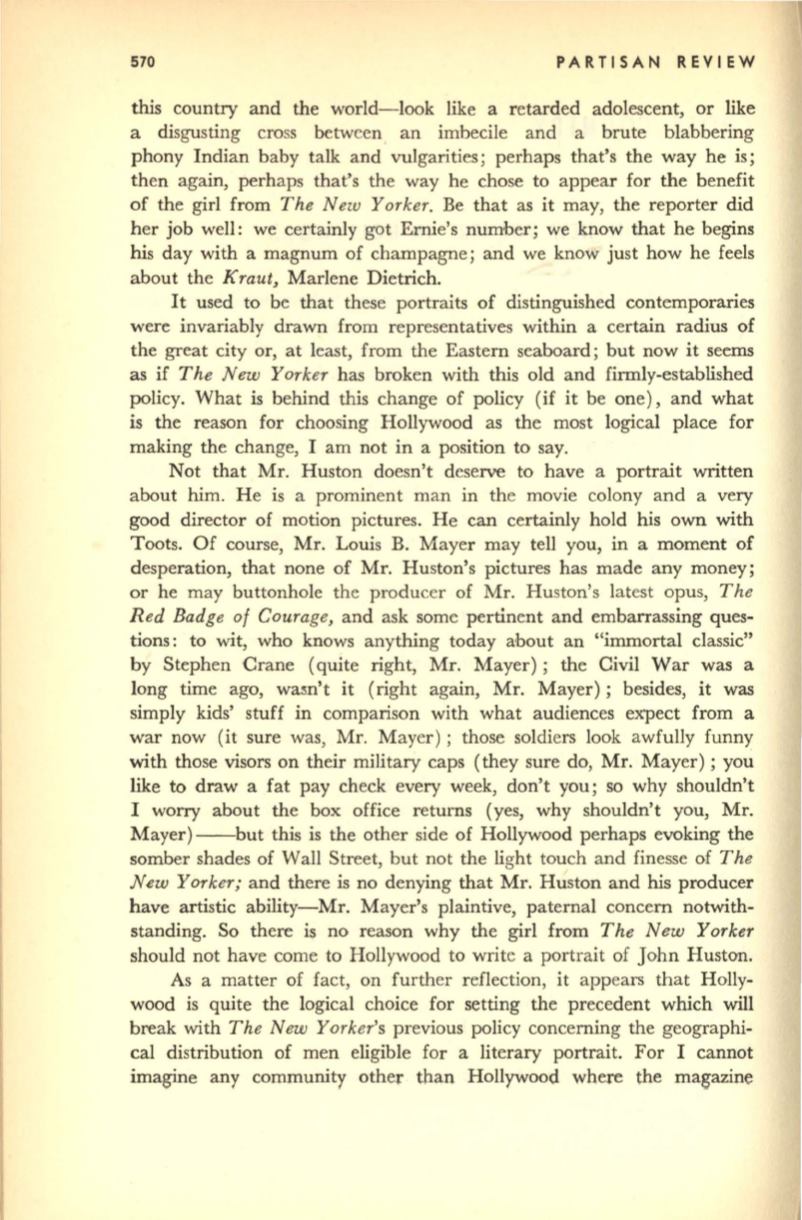
570
PARTISAN REVIEW
this country and the world-look like a retarded adolescent, or like
a disgusting cross betwcen an imbecile and a brute blabbering
phony Indian baby talk and vulgarities; perhaps that's the way he is;
then again, perhaps that's the way he chose to appear for the benefit
of the girl from
The New Yorker.
Be that as it may, the reporter did
her job well: we certainly got Ernie's number; we know that he begins
his day with a magnum of champagne; and we know just how he feels
about the
Kraut,
Marlene Dietrich.
It used to be that these portraits of distinguished contemporaries
were invariably drawn from representatives within a certain radius of
the great city or, at least, from the Eastern seaboard; but now it seems
as if
The New Yorker
has broken with this old and firmly-established
policy. What is behind this change of policy (if it be one), and what
is the reason for choosing Hollywood as the most logical place for
making the change, I am not in a position to say.
Not that Mr. Huston doesn't deserve to have a portrait written
about him. He is a prominent man in the movie colony and a very
good director of motion pictures. He can certainly hold his own with
Toots. Of course, Mr. Louis
B.
Mayer may tell you, in a moment of
desperation, that none of Mr. Huston's pictures has made any money;
or he may buttonhole the producer of Mr. Huston's latest opus,
The
Red Badge of Courage,
and ask some pertinent and embarrassing ques–
tions: to wit, who knows anything today about an "immortal classic"
by Stephen Crane (quite right, Mr. Mayer); the Civil War was a
long time ago, wasn't it (right again, Mr. Mayer); besides, it was
simply kids' stuff in comparison with what audiences expect from a
war now (it sure was, Mr. Mayer); those soldiers look awfully funny
with those visors on their military caps (they sure do, Mr. Mayer) ; you
like to draw a fat pay check every week, don't you; so why shouldn't
I worry about the box office returns (yes, why shouldn't you, Mr.
Mayer)--but this is the other side of Hollywood perhaps evoking the
somber shades of Wall Street, but not the light touch and finesse of
The
New Yorker;
and there is no denying that Mr. Huston and his producer
have artistic ability-Mr. Mayer's plaintive, paternal concern notwith–
standing. So there is no reason why the girl from
The New Yorker
should not have come to Hollywood to write a portrait of John Huston.
As a matter of fact, on further reflection, it appears that Holly–
wood is quite the logical choice for setting the precedent which will
break with
The New Yorker's
previous policy concerning the geographi–
cal distribution of men eligible for a literary portrait. For I cannot
imagine any community other than Hollywood where the magazine


